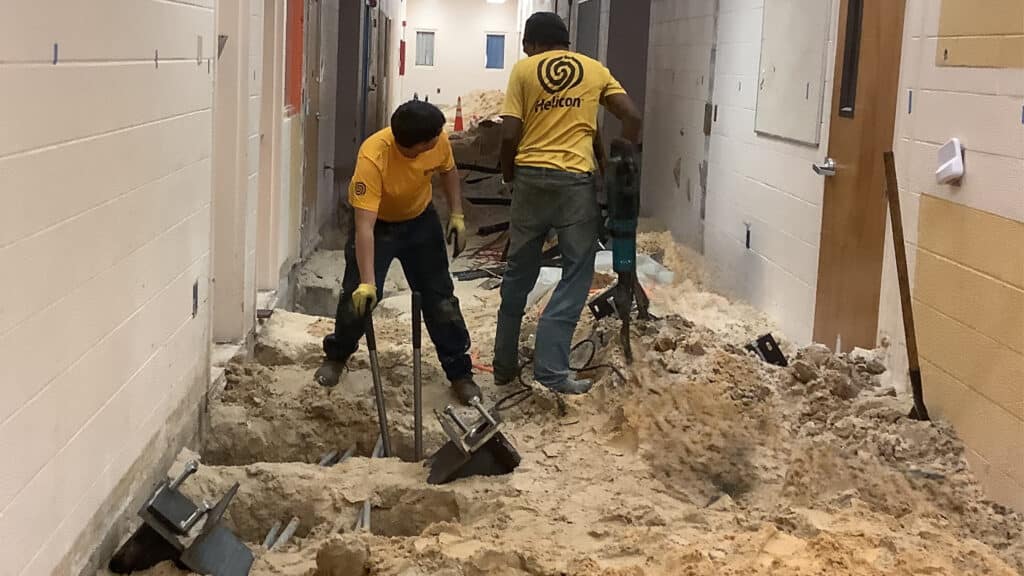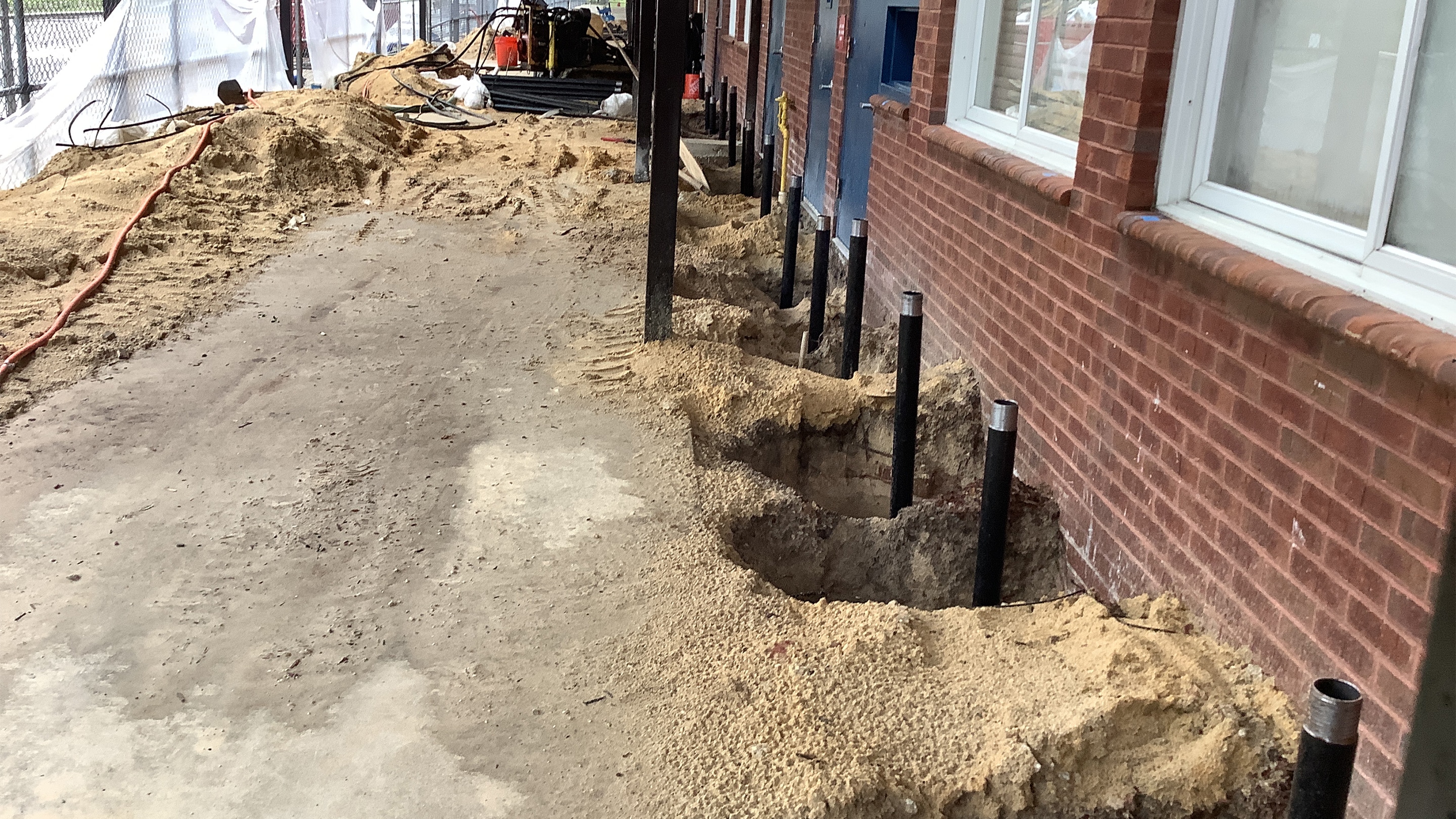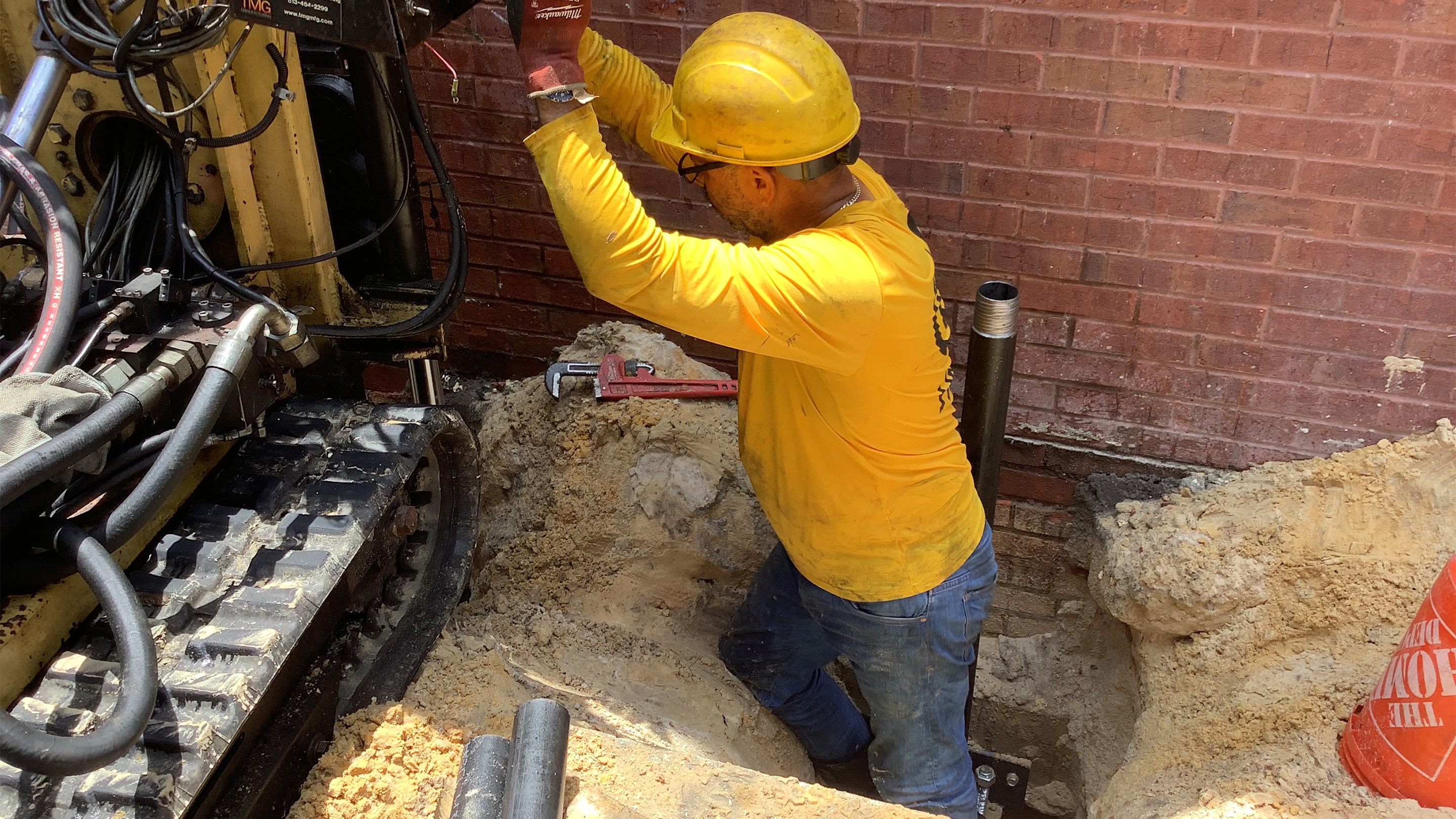- Helicon
- 9
- Deltona High School: Underpinning & Compaction Grouting to Permanently Halt Settlement
Deltona High School: Underpinning & Compaction Grouting to Permanently Halt Settlement

Deltona, FL
Market: Commercial
Solution: Foundation Repair & Soil Stabilization
Services: Underpinning (Push Piers) & Compaction Grouting
The Project
Deltona High School’s Building 2 is a daily hub for students and faculty. Settlement and subgrade loss had created a risk profile that extended beyond cosmetic cracking. Symptoms included:
- Cracking along foundation walls
- Voids and loose soils under load-bearing lines
- Uneven slab behavior within interior learning spaces
Any solution had to prioritize safety, minimize disruption, and deliver verifiable structural improvement without forcing extended shutdowns. That meant a phased plan capable of addressing both shallow soil defects and deep bearing—and documenting outcomes clearly for district stakeholders.
The Challenge
Large, occupied school buildings come with constraints that can derail ordinary repair methods. At Deltona High School, three realities shaped the plan:
- Severe soil instability: Weak, shifting ground beneath the facility demanded a method that could densify, displace, and rebuild bearing—not just fill a gap.
- Variable, unforeseen conditions: As with many Florida sites, unexpected soil behavior slowed production at times, requiring a program flexible enough to adapt in real time without compromising quality.
- Depth and reach: The building’s load path needed to bypass poor soils altogether in many locations, driving piers to extreme depths to find true bearing and to permanently stop settlement.
The Solution
Step 1 — Non-Destructive Mapping with GPR
Before putting steel or grout into the ground, Helicon performed a Ground Penetrating Radar (GPR) survey to:
- Identify utilities, conduits, and obstructions
- Map soil anomalies and potential voiding zones
- Optimize pier locations and grout injection points for coverage and safety
This pre-construction intelligence reduced risk, prevented conflicts with buried infrastructure, and tightened field production by eliminating guesswork.
Step 2 — Compaction Grouting to Rebuild the Near-Surface
With a precise map in hand, Helicon installed 3,520 linear feet of drilled casings and injected ~450 cubic yards of low-mobility compaction grout. Unlike permeation grout, compaction grout bulbs displace and densify surrounding soils, fill underground voids, and re-establish a dense, load-bearing layer beneath the structure. This step addressed the root mechanism—loose or eroded soils—so that the slab and shallow foundations would respond predictably once deep support was added.
What this accomplished:
- Closed voids beneath critical interior lines
- Increased soil density, stiffness, and uniformity
- Reduced risk of future settlement driven by vibration, moisture change, or minor surcharge
Step 3 — Underpinning with Push Piers for Permanent Bearing
To lock in long-term stability, Helicon installed 206 steel push piers, including 68 interior piers beneath load-bearing walls and 138 exterior piers around the perimeter. Piers were hydraulically driven to competent bearing strata—some to ~160 feet, using additional 5-foot sections as required—then bracketed and loaded to transfer the building’s weight to the new deep foundation. Where structure and soils allowed, controlled lift recovered elevations to relieve stress; more importantly, the underpinning permanently halted settlement by removing weak soils from the load path altogether.
Results & Benefits
Structural reliability—documented
With compaction grout densifying the near-surface and push piers carrying loads to competent strata, Building 2 moved from a reactive maintenance risk to a predictable, engineered system. The district now has confidence, backed by logs and as-built records, that the facility is safe, stable, and code-conforming for the long run.
Minimal disruption to campus life
Phased operations and small work zones allowed Helicon to coordinate around school schedules, reducing the noise, vibration, and access conflicts that can accompany heavy repairs—without compromising production or QA/QC.
A whole-building solution
Some methods patch symptoms. Here, the combination of soil stabilization + deep underpinning addressed the entire load path—from the bearing strata up through the slab—reducing differential movement that had been driving wall cracks and floor irregularities.
Budget stewardship
By avoiding demolition-and-rebuild and by executing a targeted, engineered repair, the district protected both capital budgets and instructional time—a crucial consideration for Central Florida’s growing school systems.
Why Schools & Institutions Choose Helicon
From K–12 campuses and universities to municipal and healthcare facilities across Central Florida (Orlando, Daytona Beach, Volusia, Seminole, and Orange counties), owners call Helicon when settlement risk intersects with mission-critical operations. We deliver:
- Deep foundation systems (push piers, helical piers, micropiles) tailored to Florida geology
- Ground improvement expertise (compaction grouting, permeation grouting, polyurethane void fill) to stabilize soils and slabs
- Occupied-site playbooks—tight staging, phased work windows, and clear communications that keep facilities open and safe
- Engineer-led documentation that satisfies stakeholders, code officials, and insurers alike
Homeowner/Stakeholder FAQs (Adapted for School Facilities)
Why combine compaction grouting and push piers—couldn’t we choose just one?
They solve different problems. Compaction grout rebuilds the near-surface soil matrix, closing voids and increasing density so slabs and shallow foundations respond uniformly. Push piers bypass weak soils entirely, delivering a deep, end-bearing support that permanently halts settlement. Together, they create a continuous, reliable load path.
How do you verify that soils improved and piers are carrying the load?
Grouting is tracked by point-by-point depths, pressures, and volumes, while underpinning is verified by installation logs (drive forces, refusal depth) and bracket loads. These records become the project’s as-built documentation for the district and Engineer of Record.
What about long-term performance?
With voids eliminated, near-surface soils densified, and loads carried on deep piers, the system is designed for decades of service. Routine maintenance focuses on drainage management, expansion joint upkeep, and periodic observation—no different than a healthy facility.
About Helicon
Managing a school, college, or municipal facility in Central Florida and seeing signs of settlement—cracking walls, uneven floors, or doors binding? Helicon designs and delivers engineered, occupied-site solutions that close voids, rebuild soils, and transfer loads to deep bearing—without shutting your campus down.
Schedule a site evaluation today.
Call 844-HELICON to schedule a free inspection and receive a customized stabilization plan tailored to your property or business.
FREE INSPECTION REQUEST




